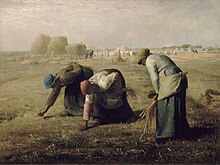Gleaning (formerly 'leasing') is the act of collecting leftover crops from farmers' fields after they have been commercially harvested or on fields where it is not economically profitable to harvest. Some ancient cultures promoted gleaning as an early form of a welfare system.[1]

Bible
Old Testament
According to the Holiness Code and the Deuteronomic Code of the Torah, farmers should leave the corners of their fields unharvested, and they should not attempt to pick up that which was dropped or harvest any left-overs that had been forgotten when they had harvested the majority of a field.[2][3][4]On one of the two occasions that this is mentioned by the Holiness Code, it adds that, in vineyards, some grapes should be left ungathered,[5] an argument made also by the Deuteronomic Code.[6]
These verses additionally argue that olive trees should not be beaten on multiple occasions, and whatever remains from the first set of beatings should be left.[7]
According to the Holiness Code, these things should be left for the poor and for strangers,[3][5] and the Deuteronomic Code commands that it should be left for widows, strangers, and paternal orphans.[4][6][7]
The Book of Ruth features gleaning by the widow Ruth to provide for herself and Naomi, also a widow.[8]
New Testament
Jesus and his disciples practiced a form of gleaning as they walked through grain fields breaking off heads of wheat to eat.[9]Rabbinical views
Gleaning by Arthur Hughes.
It was stated that the farmer was not permitted to benefit from the gleanings, and was not permitted to discriminate among the poor, nor try to frighten them away with dogs or lions;[11][12][13] the farmer was not even allowed to help one of the poor to gather the left-overs.[11][12][13]
However, it was also argued that the law was only applicable in Canaan,[14] although many classical rabbinic writers, who were based in Babylon, applied the laws there too;[15][16] it was also seen as only applying to Jewish paupers, but poor non-Jews were allowed to benefit for the sake of civil peace[17]
Modern times
Alawite woman gleaning in 1938
Nevertheless, in modern Israel, rabbis of Orthodox Judaism insist that Jews allow gleanings to be consumed by the poor and by strangers, during Sabbatical years.[19]
In eighteenth century England, gleaning was a legal right for cottagers.
In a small village the sexton would often ring a church bell at eight o'clock in the morning and again at seven in the evening to tell the gleaners when to begin and end work.[20]
This legal right effectively ended after a legal case in 1788.
In the modern world, gleaning is practiced by humanitarian groups[21] which distribute the gleaned food to the poor and hungry; in a modern context, this can include the collection of food from supermarkets at the end of the day that would otherwise be thrown away.
There are a number of organizations that practice gleaning to resolve issues of societal hunger; the Society of St. Andrew, for example, is dedicated to the role, as is the Gleaning Network in the UK.
When people glean and distribute food, they may be bringing themselves legal risk; in the Soviet Union, the Law of Spikelets (sometimes translated "law on gleaning")[22] criminalized gleaning, under penalty of death, or 20 years of forced labor in exceptional circumstances.[23]
In the US, the Bill Emerson Good Samaritan Act of 1996 limited the liability of donors to instances of gross negligence or intentional misconduct, alleviating gleaning from much of its definitions of the Good Samaritan Act, to consistently deliver surplus food from restaurants and dining facilities to emergency food centers.[clarification needed]
Gleaning in art
Gleaning was a popular subject in art, especially in the nineteenth century.Gleaning in rural France has been represented in the paintings Des Glaneuses (1857) by Jean-François Millet and Le rappel des glaneuses (1859) by Jules Breton (image), and explored in a 2000 documentary/experimental film, The Gleaners and I, by Agnes Varda.
Vincent van Gogh's sketch of a Peasant Woman Gleaning in Nuenen, The Netherlands (1885) is in the Charles Clore collection.[24]
Source: Wikipedia.org
Well I am off; well just a little bit, but I needs to get back to work. I must Keep on Keeping On!
The Man Inside the Man
from
Sinbad the Sailor Man
A
JMK's Production
Share this page
TTFN
CYA Later Taters!
Thanks for stopping by.
Donnie/Sinbad the Sailor Man
P.S. Sweet Sixteen My Breakout Year's Hottest and Fastest Growing Biz Op? Do You Want In? If You Do! Click Here and Sign Up!




No comments:
Post a Comment